TEMICTLA, Mexico – If there were ever any doubt that Quetzalcoatl lives, that doubt was dispelled in one moist, glistening, luminous week in the heart of Mexico.
Here in Temictla, a sacred valley, a tiny ecovillage and spiritual retreat center on the edge of Chalmita, a pilgrimage destination to millions of people of diverse traditions, a far-flung family reunited under the light of a waxing moon in November of 2013. It’s a family of many nations and many traditions, a family whose multitudinous members have dedicated themselves heart and soul to the survival of humanity and of life on Earth.
Nearly everyone among the almost 500 people present – people representing dozens of different nations, tribes, traditions and peoples – would have agreed that the key ingredient to survival in the difficult times that face us all in the years ahead is extremely complex and at the same time profoundly simple. It all comes down to one word: love.
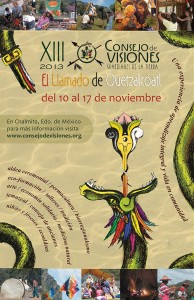 The 13th Consejo de Visiones – Guardianes de la Tierra (Vision Council-Guardians of the Earth) may have taken on a grandiose title by the standards of First World observers. The name of their 13th gathering in 20 years – Llamado del Quetzalcoatl, Call of the divine plumed serpent that connects the material world with the spiritual – was nothing if not prophetic. But for those who were present, the proposition was not only realistic, but urgently necessary: The proposition that, facing a world of destructive climate change, economic crisis, organized crime and environmental devastation, there is an answer. The answer does not lie in the dogma of a particular religion or the platform of a political party or the brilliant proposals of our reigning technocracy. The answer lies in the hearts of each and every person on the face of the planet, in particular those who are answering a global call to work together for our planetary survival in this challenging time, this time of transition to a new, respectful and regenerative civilization.
The 13th Consejo de Visiones – Guardianes de la Tierra (Vision Council-Guardians of the Earth) may have taken on a grandiose title by the standards of First World observers. The name of their 13th gathering in 20 years – Llamado del Quetzalcoatl, Call of the divine plumed serpent that connects the material world with the spiritual – was nothing if not prophetic. But for those who were present, the proposition was not only realistic, but urgently necessary: The proposition that, facing a world of destructive climate change, economic crisis, organized crime and environmental devastation, there is an answer. The answer does not lie in the dogma of a particular religion or the platform of a political party or the brilliant proposals of our reigning technocracy. The answer lies in the hearts of each and every person on the face of the planet, in particular those who are answering a global call to work together for our planetary survival in this challenging time, this time of transition to a new, respectful and regenerative civilization.
No one knew what to expect; a steady drumbeat of violent headlines had continued to emerge from Mexico in the months leading up to the gathering. A message went out around the globe in the weeks before the event. “Do not fear what you read and watch in the media,” wrote Coyote Alberto Ruz, one of the Consejo founders. “It happens, but it won’t happen in our gatherings; fear kills more than the bullets, and bullets do not come our way, we move in different dimensions and planes, and these are times of love! Not of fear!!!”
Coyote’s words seemed to create a spell of wellbeing, as did those of Laura Kuri, another cofounder. This was a special year for the group as it was closing several cycles and beginning a new one. The Consejo was coming of age, celebrating the 21st anniversary of its founding with this event. It was the 13th Consejo, a convocation that had been held in diverse locations from Mexico to Brazil; and it was the fourth and final year in Chalmita, the fourth year since the group returned to Mexico after launching a 13-year pilgrimage through Latin America of an itinerant ecovillage called the Rainbow Peace Caravan. After four years of security in this sacred valley, it would be time to find a new home.
“There are too many synchronicities to miss it, to live your dreams and to share the magic of the winged serpent in flight,” wrote Laura in another missive. “Will you miss it? We think not.”
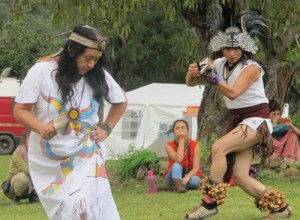 By the time the event was over, more than 14 countries and a dozen different tribes were represented. Headlines notwithstanding, the call had been heard around the world. The transcendent work of the winged serpent – infusing the material with spirit, and grounding the spirit in real-life earth-based work for change – had begun.
By the time the event was over, more than 14 countries and a dozen different tribes were represented. Headlines notwithstanding, the call had been heard around the world. The transcendent work of the winged serpent – infusing the material with spirit, and grounding the spirit in real-life earth-based work for change – had begun.
Climate change was an inevitable theme of the gathering, given that the event began with a severe and untimely dry-season thunderstorm. A band of Mexica (Aztec) dancers were performing their invocation to the seven directions in preparation for the opening ceremonies when the skies opened and Tlaloc, the Storm God of the Aztecs, sent an indisputable message. The best-laid plans of humans will need to defer to a higher power in these dangerous times, these times of change. Madre Tierra, Tonantzin, the Mother Force, will have her way, and we must be mindful.
I’d been to this sacred valley more than once, enough to be embraced by the soaring cliffs that surround this green valley where the Consejo has met for the past four years, and by the very heart of this rainbow-colored tribe. Enough to know that wherever they go, I have lessons to learn, I have work to do, and above all, I am home.
I already knew that the rhythm of my days would be marked by the soaring call of the caracol, by the rise and fall of Father Sun and Grandmother Moon. I already carried within me the songs and the prayers I had learned from these people whose homes are everywhere, but above all, close to the Earth. So it came as no surprise that this downpour would be a received as a teaching: our lesson was to go with the flow.
Sunday dawned damp and luminous with a Salute to the Sun. The various consejos or councils set about their work: setting up camp and kitchen and workspaces, giving workshops, networking, sharing stories and hammering out a work plan for the year ahead. Education, health, ecology, art and culture, community, tradition, spirituality and New Time were a few of the thematic councils that met over the course of the week.
 Children and youth met in their own councils as they had for years, and this year something new happened: an Elders Council was launched by a handful of the Vision Council’s senior members, and they created a new space for ceremony, conversation and consultation for people of all ages, a teepee with a glowing altar at its warm copal-scented heart. One couple even sealed their bond here with a wedding in the Elders Council Teepee.
Children and youth met in their own councils as they had for years, and this year something new happened: an Elders Council was launched by a handful of the Vision Council’s senior members, and they created a new space for ceremony, conversation and consultation for people of all ages, a teepee with a glowing altar at its warm copal-scented heart. One couple even sealed their bond here with a wedding in the Elders Council Teepee.
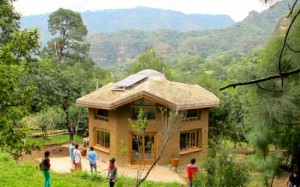 Lourdes Malvido, a bioconstruction architect who built a beautiful two-story octagonal straw-bale house near here, led participants on a ten-minute hike to see the home and discuss the multiple ecological building and permaculture techniques incorporated there. A number of the volunteers who had lent their labor to its construction during the 2011 Consejo de Visiones were present to marvel at its finished and gracefully lived-in state.
Lourdes Malvido, a bioconstruction architect who built a beautiful two-story octagonal straw-bale house near here, led participants on a ten-minute hike to see the home and discuss the multiple ecological building and permaculture techniques incorporated there. A number of the volunteers who had lent their labor to its construction during the 2011 Consejo de Visiones were present to marvel at its finished and gracefully lived-in state.
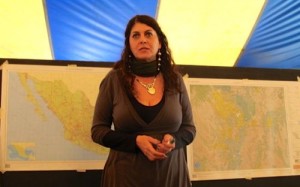 Various consejos shared a day of workshops, performances, and other activities in the nearby pueblo of Chalmita. Then Laura Kuri, founder of the Bioregional Movement in Mexico and Latin America, led a workshop discussing the special significance of this region, the Bosque de Agua, the lush and highly diverse rainforest that recharges the 20 aquifers that provide most of the water for the 29 million inhabitants of Mexico City. In breakout sessions that included veteran activists and newcomers invited from neighboring communities, participants worked together to create a plan for a water drainage system that would not contaminate this vital resource.
Various consejos shared a day of workshops, performances, and other activities in the nearby pueblo of Chalmita. Then Laura Kuri, founder of the Bioregional Movement in Mexico and Latin America, led a workshop discussing the special significance of this region, the Bosque de Agua, the lush and highly diverse rainforest that recharges the 20 aquifers that provide most of the water for the 29 million inhabitants of Mexico City. In breakout sessions that included veteran activists and newcomers invited from neighboring communities, participants worked together to create a plan for a water drainage system that would not contaminate this vital resource.
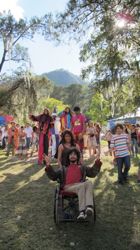 The crowning event of each day was presented by the Consejo de Arte y Cultura (Art and Culture Council), a loosely affiliated collective of visual and performance artists, technicians and engineers who donate their knowledge and their art in service of the Pachamama. In the past four years of the Vision Council’s presence in Chalmita, some of the biggest names on the Mexican music scene graced the stage, including Ruben Albarran of Café Tacuba, Roco Pachukote of Maldita Vecindad and Sonidero Mestizo, Lengualerta and Pachamama Crew.
The crowning event of each day was presented by the Consejo de Arte y Cultura (Art and Culture Council), a loosely affiliated collective of visual and performance artists, technicians and engineers who donate their knowledge and their art in service of the Pachamama. In the past four years of the Vision Council’s presence in Chalmita, some of the biggest names on the Mexican music scene graced the stage, including Ruben Albarran of Café Tacuba, Roco Pachukote of Maldita Vecindad and Sonidero Mestizo, Lengualerta and Pachamama Crew.
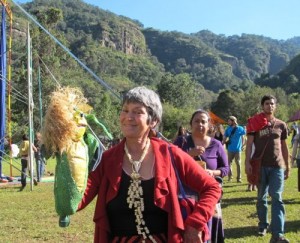 But art flourished in every corner of the event, from the colorful signs outside the composting toilets (“In this sacred place we return the gifts of the Mother Earth”) to the rainbow-colored clothing of participants to the internationally inspired menus of the kitchen staff to the catchy dance lyrics composed by the ecology council (“Baile sostenible,” Dance sustainably). As Luix Saldaña, Malinalco-based musician and longtime Consejo art and culture coordinator, admonished the crowd at the closing performance: “Always remember, tiempo es arte (time is art)” – a theme that has infused itself into the very fiber of this group’s essence.
But art flourished in every corner of the event, from the colorful signs outside the composting toilets (“In this sacred place we return the gifts of the Mother Earth”) to the rainbow-colored clothing of participants to the internationally inspired menus of the kitchen staff to the catchy dance lyrics composed by the ecology council (“Baile sostenible,” Dance sustainably). As Luix Saldaña, Malinalco-based musician and longtime Consejo art and culture coordinator, admonished the crowd at the closing performance: “Always remember, tiempo es arte (time is art)” – a theme that has infused itself into the very fiber of this group’s essence.
Also under the auspices of the Art and Culture council, one of the most iconic and thought-provoking films to be made in the country in recent years, “Hecho en México (Made in Mexico),” filmed a portion at the Consejo in 2010 and held its premiere here in 2011.
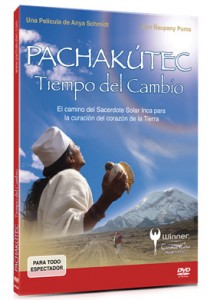 Three brand-new films were screened at this year’s event, including Pachakútec: Time of Change, the documented pilgrimage of Ñaupany Puma, a young sun priest of the Inca tradition to sacred sites all over the world; and Land Awakening (Despertar de la Tierra), a pilgrimage of a different sort by Mexican-Canadian filmmaker Raúl Alvarez, whose journey to farms around the world was a quest to understand our relationship with the land. Ñaupany and Raul presented their films and lived and worked alongside us for the duration of the Consejo.
Three brand-new films were screened at this year’s event, including Pachakútec: Time of Change, the documented pilgrimage of Ñaupany Puma, a young sun priest of the Inca tradition to sacred sites all over the world; and Land Awakening (Despertar de la Tierra), a pilgrimage of a different sort by Mexican-Canadian filmmaker Raúl Alvarez, whose journey to farms around the world was a quest to understand our relationship with the land. Ñaupany and Raul presented their films and lived and worked alongside us for the duration of the Consejo.
Abuelo Suaga Gua Ingativa Neusa, an indigenous elder from Colombia’s Muisca tribe, led workshops and shared wisdom and sacred medicine, as did Roberto Perkins from the Comcaac or Seri people of the Sonora state of Mexico, and Victoria Anahi Ochoa of the Yaqui people.
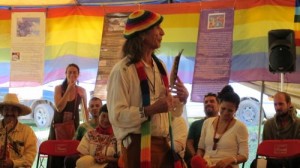 Alberto Ruz, Holger Hieronomi, Arnold Ricalde and numerous others who had helped form a new network of ecovillages and sustainability initiatives called CASA (Consejo de Asentimientos Sustentables de las Americas) met during the week to set a course for the activation of this new resource for local and global consciousness-shifters. A new branch of CASA-Jalisco was formed with an eye toward building networks in Mexico’s second-largest city – Guadalajara – and the surrounding state.
Alberto Ruz, Holger Hieronomi, Arnold Ricalde and numerous others who had helped form a new network of ecovillages and sustainability initiatives called CASA (Consejo de Asentimientos Sustentables de las Americas) met during the week to set a course for the activation of this new resource for local and global consciousness-shifters. A new branch of CASA-Jalisco was formed with an eye toward building networks in Mexico’s second-largest city – Guadalajara – and the surrounding state.
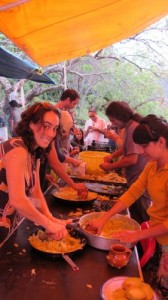 Besides the workshops, there was the business of running the encampment – a responsibility of everyone, as this was a nonprofit, self-organizing event. Each participant was responsible for taking on workshifts for cooking and cleaning and managing the composting toilets. Workdays began early and ended late – but this is Mexico, where all work and no play would be culturally unacceptable. So as the light began to fade from the skies, it began to rise in a rainbow of colors from the central stage, where dance and puppetry and music drew everyone back together with some of the best talent from the heart of Mexico and beyond.
Besides the workshops, there was the business of running the encampment – a responsibility of everyone, as this was a nonprofit, self-organizing event. Each participant was responsible for taking on workshifts for cooking and cleaning and managing the composting toilets. Workdays began early and ended late – but this is Mexico, where all work and no play would be culturally unacceptable. So as the light began to fade from the skies, it began to rise in a rainbow of colors from the central stage, where dance and puppetry and music drew everyone back together with some of the best talent from the heart of Mexico and beyond.
The week passed in a colorful, heart-filled blur. For me, this Consejo included a very special element, as for the first time, 16 members of my home community, Teopantli Kalpulli, the Village of the Sacred Standard, attended the event. We traveled together, gathered at meals and shared responsibilities, learning more about each other and growing as a team. And as the event drew to a close, our leader, Abuela Esperanza Moran, delivered the proposal we simultaneously longed for and dreaded: The proposition that the next Consejo de Visiones be held in our community, just as it was 20 years ago, when the Kalpulli was just a few buildings and a big dream. The proposal will be considered in the months ahead, and our lives will take shape accordingly.
The last morning dawned like the others, but with a poignant hue in the rosy sunrise. Time to take down the tents, put out the fires, and engrave each name, each face on our hearts and minds as we return to the mundane world… but only for awhile. Soon enough, the call of the caracol will bring us together again.
Created with Admarket’s flickrSLiDR.
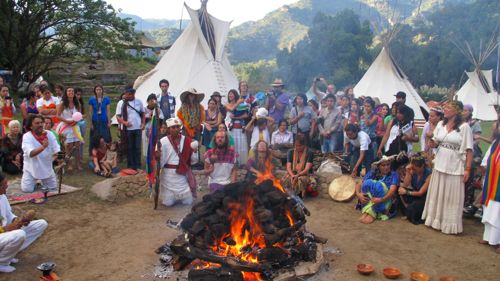
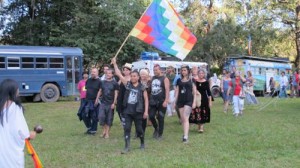
Leave a Reply